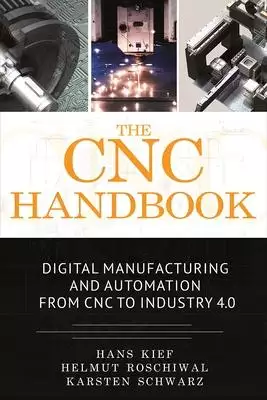Precision Machinery的問題,透過圖書和論文來找解法和答案更準確安心。 我們查出實價登入價格、格局平面圖和買賣資訊
Precision Machinery的問題,我們搜遍了碩博士論文和台灣出版的書籍,推薦Kief, Hans Bernhard,Roschiwal, Helmut A.,Schwarz, Karsten寫的 The Cnc Handbook: Digital Manufacturing and Automation from Cnc to Industry 4.0 和的 XIV International Scientific Conference "Interagromash 2021": Precision Agriculture and Agricultural Machinery Industry, Volume 都 可以從中找到所需的評價。
這兩本書分別來自 和所出版 。
國立陽明交通大學 機械工程系所 洪紹剛所指導 吳育昕的 具摺紙鉸鍊雷射光束掃描器之設計 (2021),提出Precision Machinery關鍵因素是什麼,來自於雷射轉向系統、音圈致動器、紙鉸鍊、低成本製造方法、紙張作為轉向鏡系統。
而第二篇論文國立臺灣科技大學 電機工程系 陳雅淑所指導 楊為屹的 提高可變電阻式記憶體神經網路加速器之利用率與能效的排程方法 (2021),提出因為有 Neural network acceleration、Processing-in-memory、ReRAM crossbar array的重點而找出了 Precision Machinery的解答。
The Cnc Handbook: Digital Manufacturing and Automation from Cnc to Industry 4.0

為了解決Precision Machinery 的問題,作者Kief, Hans Bernhard,Roschiwal, Helmut A.,Schwarz, Karsten 這樣論述:
Introducing computers into production engineering has drastically reduced the "artisan skill" content traditionally required in manufacturing processes and replaced it with high-precision, computer-controlled machinery. While this reduces human error and variability in output, it does not eliminate
the knowledge required of the professional engineering or shop floor worker. On the contrary, the reverse is true. Managers, engineers, and workers still need to understand the fundamentals while they need to acquire other skills. These highly-regarded authors combine more than 150 years of industri
al and academic experience and expertise to provide readers with the fundamentals of the subject, from digital manufacturing with CNC machine tools and FMS up to Industry 4.0, emphasizing the increased importance of automated manufacturing based on computerized systems (CAD, CAM, CAQ, etc.).Features
This groundbreaking work introduces readers to CNC fundamentals, followed by a number of chapters which explain how different components are applied in practice.This logical approach is extended to the study of CNC and drives, tooling, flexible manufacturing systems (FMS), and finally to NC-programm
ing, DNC, digital manufacturing, Industry 4.0 and computer integrated manufacturing (CIM).Additional chapters cover industrial robots, additive manufacturing, energy-efficient manufacturing, simulation systems, state of the art of machine integrated measuring systems, and using touch probes and lase
r beams.Explains the functions and connections of all integrated components. Hans Bernhard KIEF has 35 years of experience in the field of NC/CNC machine tools and manufacturing automation with Robert Bosch GmbH in Germany. He was a visiting professor at the University of Mannheim for many years a
nd was acknowledged as one of the world’s leading experts in the field of CNC manufacturing and Flexible Manufacturing Systems (FMS). In his professional capacity, he has traveled widely through the United States and Europe and has worked as a consultant in the manufacturing industry, having designe
d and developed special CNC reliability software for the aircraft and automobile industry.Helmut A. Roschiwal earned his apprenticeship at Messerschmitt AG (today: Premium Aerotec). He has a degree in mechanical engineering. He was previously head of development and CEO at Holtschmidt Entwicklungen.
In 1984, Roschiwal founded own company, Roschiwal+Partner Engineering GmbH in Augsburg. In 2008, he handed over leadership of company to next generation; Since then, he is active on the board of advisors and is a frequent author.Karsten Schwarz has a degree in precision engineering; from 1985 to 19
89 he was in electrical construction at Heckert Machine Tools; From 1990 to 1995 he was a service engineer and promoted to product manager CNC Sinumerik; From 2017 through the present he is the head of the Siemens Technology and Application Center in Erlangen, responsible for Siemens CNC training ac
tivities worldwide.
Precision Machinery進入發燒排行的影片
Hello friends.
This is the official channel of JSK-koubou.
Here you can find many interesting videos about homemade machinery, woodworking projects, plans and life hacks.
I propose a method to easily make high-precision 45-degree and 90-degree jigs from freehand-cut wood.
Click here for the plan
https://jisaku-koubou.com/downloads/90jigs
[Plan List]
https://jsk-koubou.stores.jp/
具摺紙鉸鍊雷射光束掃描器之設計
為了解決Precision Machinery 的問題,作者吳育昕 這樣論述:
本論文提出使用紙張摺疊的設計理念,來達成雷射振鏡的導引驅動機構。紙張透過雷射雕刻機可雕刻出任意複雜的圖案,再經摺疊成致動鉸鍊,實現製作快速且技術簡單的雷射振鏡導引驅動機構。相比於傳統軸承以及撓性鉸鍊,傳統軸承本身造成的摩擦力,會影響鏡子其控制上的困難;而撓性鉸鍊可避免旋轉元件彼此間隙產生的誤差及接觸面相對運動所造成的磨耗,擁有低誤差、高工作壽命的優點,可應用於精密機械的作動,但是撓性鉸鍊大致為金屬製成,整體重量重,製作也較為麻煩和耗時。而紙鉸鍊不但解決傳統元件所造成的磨耗,且相較於其他材料來說可以使用較小的驅動力來達到較大的行程量。且雷射振鏡運作幾次,紙張都不會發生斷裂,但是紙張的共振頻率有
逐漸變小的趨勢,直到2000萬次後才趨於定值,代表著紙張的剛性強度有些許改變,使紙張變軟。而系統的平均安定時間為114 ms,重複精準度平均為8.49 ×10-4 °
XIV International Scientific Conference "Interagromash 2021": Precision Agriculture and Agricultural Machinery Industry, Volume

為了解決Precision Machinery 的問題,作者 這樣論述:
提高可變電阻式記憶體神經網路加速器之利用率與能效的排程方法
為了解決Precision Machinery 的問題,作者楊為屹 這樣論述:
電阻式記憶體成為加速嵌入式系統中神經網路推理的新興解決方案。為了减少神經網路的延遲,所有預先訓練好的權重會先寫入在電阻式記憶體中,以執行神經網路的推理階段。 然而,由於部署的神經網路數據依賴性,常導致低系統利用率,並浪費能耗。本論文中,我們提出了一種排程引擎,用於提高基於電阻式記憶體的加速器之利用率和能源效率。我們提出的排程引擎通過延遲推理運算的起始時間與運行時的權重寫入,回收空閒時間,進而提高能源效率以及資源利用率。相較於通過權重複製於多個記憶體單元來避免空閒時間,排程引擎能够在有限資源下執行多個神經網路,進而提升系統利用率和能源效率。實驗結果表明,與現有基於電阻式記憶體的加速器相比,搭配
本論文提出的排程引擎最多可降低50%的耗能,以及提升37%的效能。